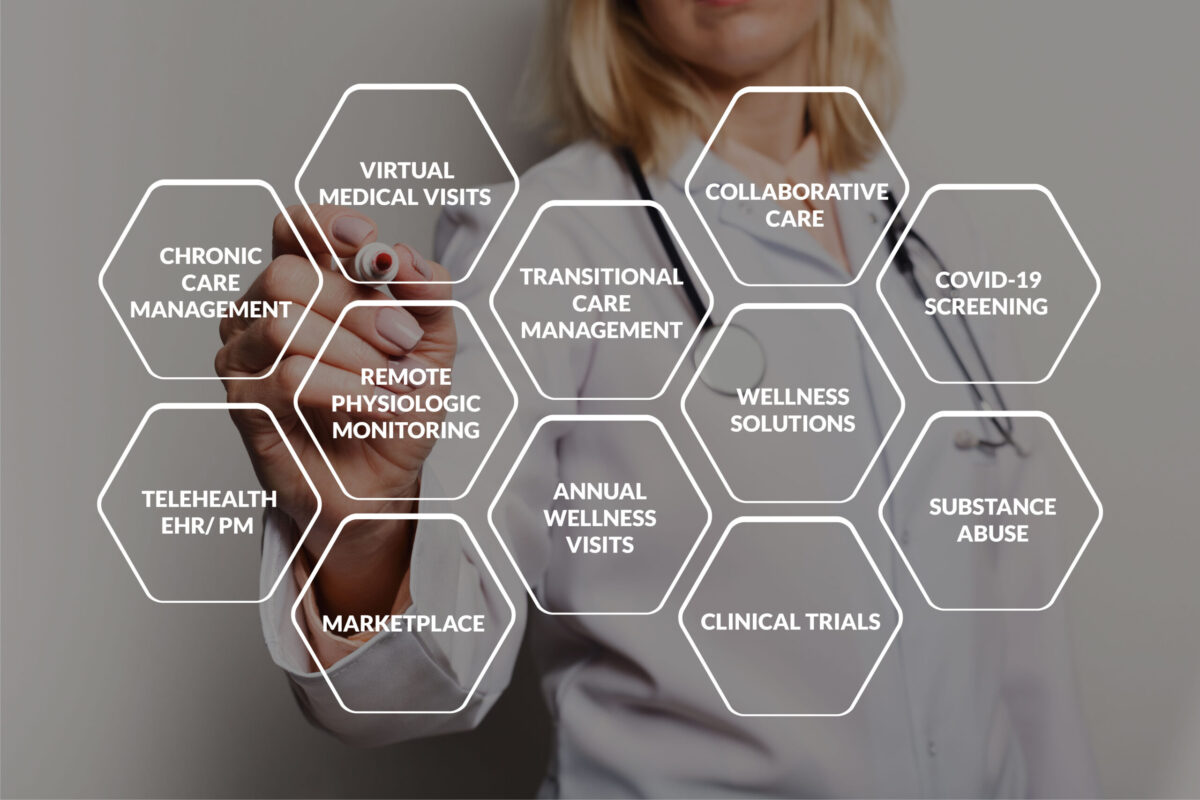Robust Telehealth Solution for Companies of All Sizes
Chronic Care Management
CareVitality has been providing Chronic Care Management support since 2016.
We work with chronic care patients who have one or more chronic conditions and manage and monitor their health with telehealth visits under a physician’s direction in between medical visits. These additional appointments are convenient to patients, low cost to companies and effective in providing the extra care these patients need.
Remote Monitoring for Enhanced Medical Care
Transitional Care Management
We work closely with your members to make sure they have 24/7 access to care, meals, transportation and caregiver services when needed, providing extra touch points beyond what their doctor can manage.
Telehealth Solutions for Physical and Mental Health
- Remote Physiologic Monitoring
- Collaborative Care
- Annual Wellness Visits
- Chronic Care Management
- Behavioral Health Integration
- Transitional Care
- Annual Wellness Visits
- Substance Abuse
- Clinical Trials
- Wellness Solution
- Annual Wellness Visits
- Health Risk Assessments
Technology Services
- Healthcare IT System Selection
- Project Management
- Implementation Support
- Training
- Managed Services
- Cybersecurity Services
- Cybersecurity Risk Analysis
- Vulnerability Scanning
- Penetration Testing
- Network Analysis
- Analytics
- Cloud-based services
- Software Development
How we Compare to Telemedicine Companies?
Learn How CareVitality Telehealth Solutions for Your Organization
FAQs
What is difference between telehealth and telemedicine?
Telemedicine and telehealth are similar terms, but they are not interchangeable. Telehealth refers to a broader range of healthcare services delivered through technology, while telemedicine, is a component of telehealth, specifically referring to using technology to deliver clinical services.
Telemedicine involves the use of technology to deliver clinical services, such as consultations, diagnoses, and treatment plans. Telemedicine can involve multiple communication methods, including video conferencing, secure emails through a patient portal, and phone consultations.
Telehealth includes a wide range of services beyond just clinical care, such as remote patient monitoring, mobile health, and patient education. Additionally, you can get most prescriptions that you need via telehealth.
Overall, telehealth is a broader term that encompasses a wide range of healthcare services delivered through technology, while telemedicine specifically refers to the delivery of clinical services through technology.
What are the three major ways telehealth services are delivered?
The three major ways telehealth (or telemedicine) services are provided:
- Live video conferencing: This involves secure video conferencing technology to be used between healthcare providers and patients to deliver real-time video consultations. Live video conferencing technology can be used to deliver many services including mental health consultations, primary care, specialty care, follow-up appointments, and urgent care consultations.
- Asynchronous communication: This involves the transmission of patient medical information, such as images, test results, or medical histories, to a healthcare provider or specialist for review and consultation at a later time. Asynchronous communication, also referred to as store-and-forward, is useful for remote diagnosis, referrals, and consultation. This can allow the healthcare provider to review this information when they are available and later communicate with the patient regarding the findings , provide a diagnosis if pertinent and deliver a treatment plan to the patient if needed.
- Remote patient monitoring: This involves the use of technology to remotely monitor patients’ health status, such as through wearable devices or sensors that track vital signs and/ or medication adherence. Remote patient monitoring allows for continuous monitoring and early detection of potential health problems, which can improve patient health outcomes, reduce ER visits and lower hospital readmissions.
These three ways telehealth services are delivered can be used individually or in a combination based on the patient’s health needs and the healthcare provider’s choice and functionality. They options give ease in the delivery of healthcare services and provide flexibility, while also improving access to care for patients who may not be able to be in-person or on site to receive healthcare services.
How do I choose a telehealth platform?
Below are steps to take to help evaluate several factors to choose the best telehealth platform for your organization:
- Needs Assessment: Start by defining your company’s specific needs for telehealth. Consider the type of services you will be offering, the features needed and who will be using the telehealth platform. Will you need a telemedicine company or a telehealth company? Will mental health services need to be included?
- Research various telehealth platforms: Once you have identified your company’s needs, research different telehealth platforms to understand the features and functionalities that match meet your requirements and potentially exceed them. Consider factors such as ease of use, security, compatibility with your existing health systems (EHRs), efficiency and pricing. Read company and platform reviews to ensure your vendor has a good reputation.
- Have a demonstration of the platform: Before committing to a platform, have a demonstration of the platform to see if it meets your needs. Additionally, if you feel the need to see if you can practice with a test patient but sometimes it is better to be trained before using a test patient if the telehealth systems are complex to meet your needs.
- Check for HIPAA compliance: In the United States, it is important for a provider to choose a platform that is HIPAA compliant to ensure the privacy and security of electronic protected health information (ePHI).
- Reference Checking: Look for reviews, references and testimonials from other healthcare providers who have used the platforms and/ or telehealth services you are considering. Ask for recommendations from colleagues or other healthcare professionals in your network.
- Identify Integration Needs: If you use an electronic health record (EHR) system or other healthcare software applications, determine if there is a telehealth platform that can integrate with your existing systems that has reasonable integration costs if any to streamline workflows and improve efficiency.
- Evaluate customer support: Look for a platform that has solid customer support to address any technical issues or questions in a timely manner.
These steps will help you identify a telehealth platform to meet your company’s needs and help you deliver excellent telehealth services.
What are the pros and cons of telehealth?
Below are a list of pros and cons as it relates to what telehealth solutions provide (and although CareVitality does not provide telemedicine, the same pros and cons apply to telemedicine solutions).
Pros for patients and companies:
- Accessibility: Telehealth improves access to healthcare services, particularly for patients who have transportation issues, mobility issues, live in underserved or remote areas, or face additional barriers to receiving in-person health care.
- Convenience: Telehealth is convenient for patients by allowing them to receive primary care or healthcare services from their own home or company office, without additional expense and time needed for travel or lost wages to take time off work.
- Cost-effective: Telehealth can reduce healthcare costs by eliminating the need for travel, decreasing hospital readmissions, and efficiently delivering healthcare in a cost-effective manner by utilizing telehealth providers to supplement doctor visits.
- Outcome Improvement: Telehealth has been shown to reduce hospitalizations, decrease ER visits, increase time at work or jobs, and improve health outcomes for patients with chronic health conditions.
Cons for patients or businesses:
- Technical difficulties: Technical issues such as incompatible devices or poor internet connectivity or lack of internet connectivity can hinder or disrupt the delivery of care services.
- Limited physical examination capability: Telehealth may be unable to provide the same level of physical examination needed based on the issue or hands-on treatment that in-person care can provide. Any lab tests ordered would still require an in person visit to a doctor or healthcare facility.
- Limited personal interaction: Telehealth may not offer the same level of personal interaction or patient-physician relationship that in-person care can provide which can leave a patient feeling disconnected from their provider and not as willing to follow the health recommendations made by their provider.
- Limited Coverage: Telehealth services may not be covered by all health plans, which can limit access for some patients. Insurance coverage needs to be checked for patients before enrolling in telehealth or telemedicine visits.
- Need for specialized training: Patients may not be as well versed in how to use the technology to receive telehealth services since the telehealth solution may not be as easy to use for patients. Healthcare providers may need specialized training to effectively provide telehealth services.
Overall, telehealth solutions have the potential to improve health outcomes by giving easy access to healthcare services while reducing healthcare costs for patients, companies and health plan providers, but there are some barriers that need to be addressed to effectively deliver telehealth services.








